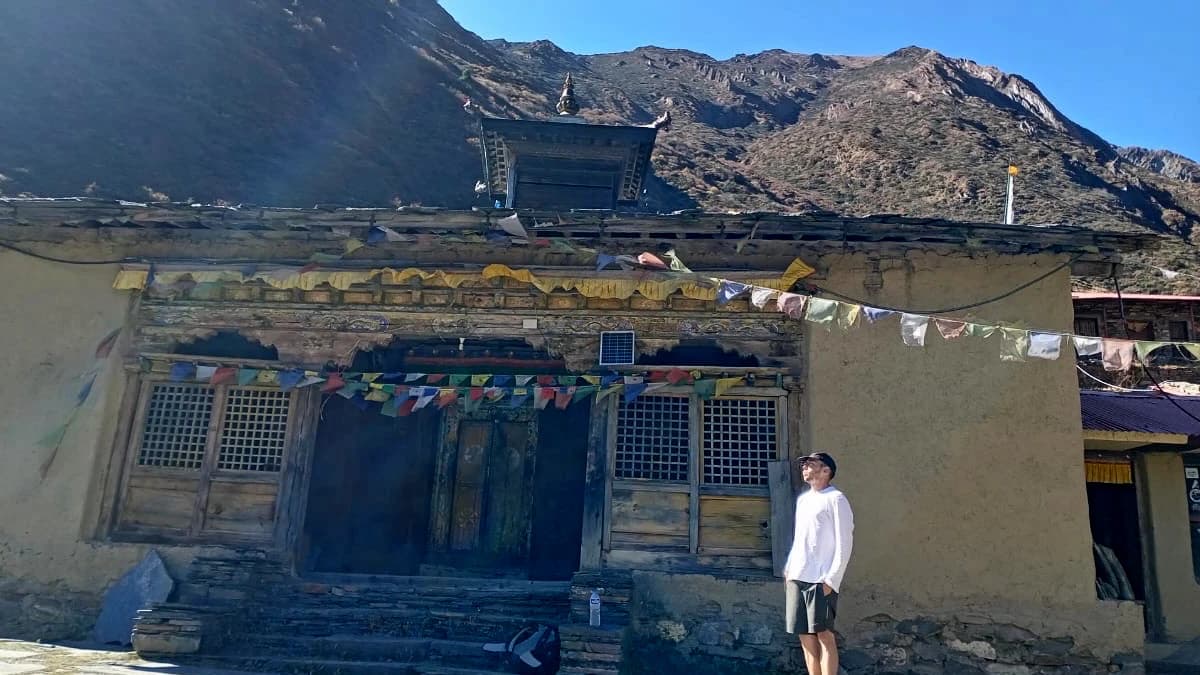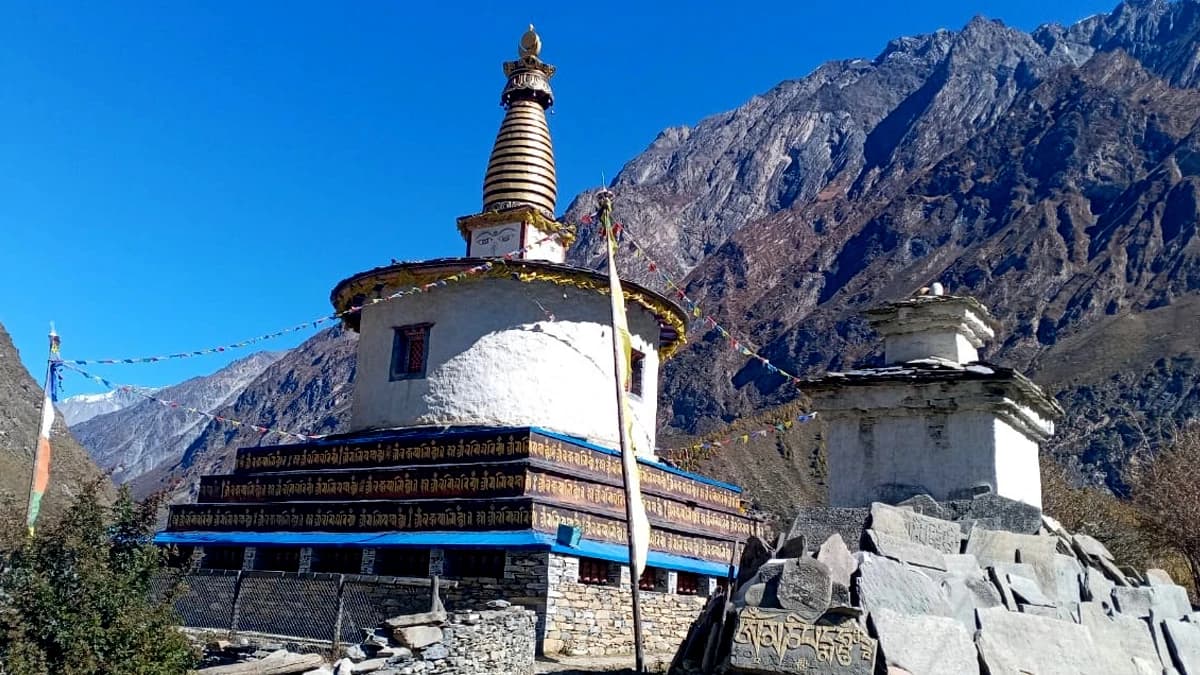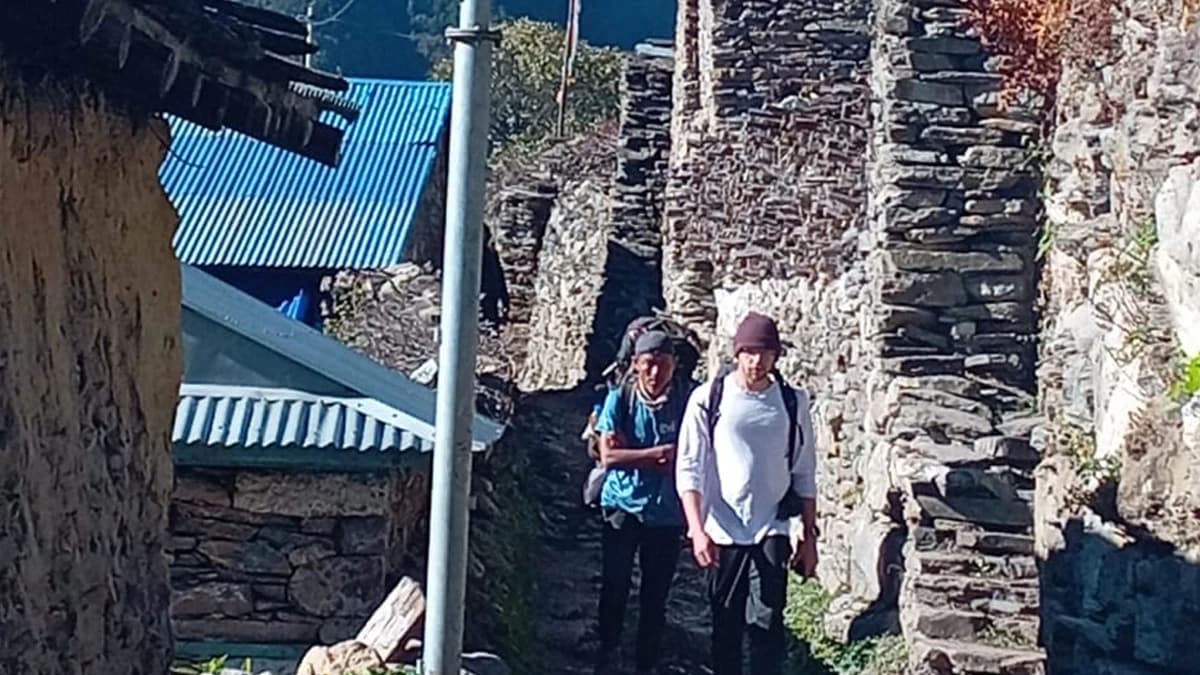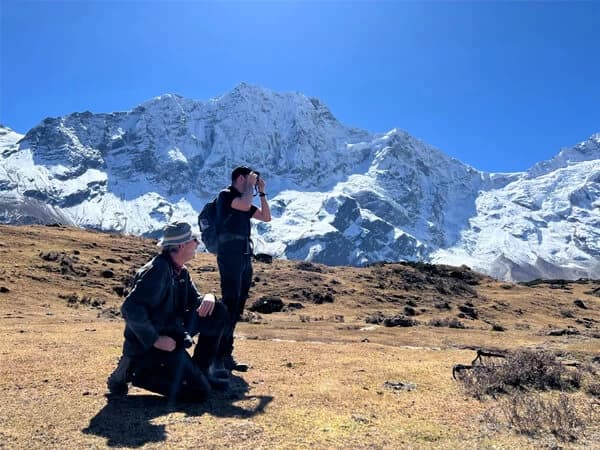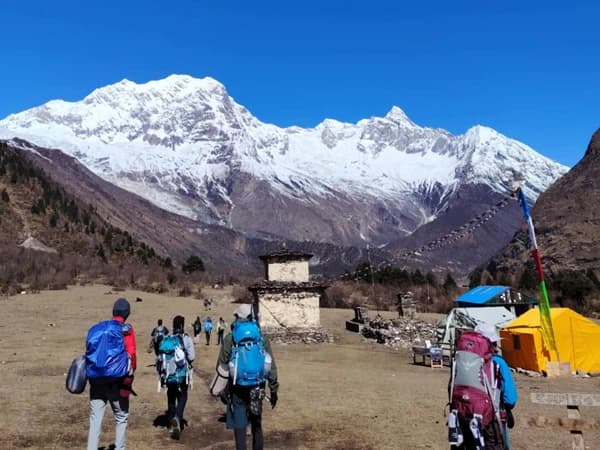Venture out to one of the most treasured assets of the Himalayas, "Tsum Valley," where the ancient Tibetan Buddhism culture is preserved, with five hidden sacred monasteries amid the Himalayas within the Manaslu region, far away from the modern influx. Shower yourself with the great mountain views, landscapes, and glacial valleys, with rich cultural exploration of the scheduled valley in Nepal. Are you ready to thrive in with Tibetan-descendant community where every step transports you back to the 90s era? A meaningful yet thrilling journey awaits you!
Tsum Valley Trekking Overview:
Located in the northern Gorkha, Tsum Valley is one of the most isolated valleys, which lies near the Nepal-Tibet Border that is known as "Tsum Cho Tsuksum," which means 13 provinces ruled as a single territory due to its distinct culture and historical status. Hence, one can imagine how deeply this territory is connected with its roots, which sit behind the massive Ganesh Himal Range and Manaslu Range far away from civilization, due to its remoteness, the ancient culture and the pristineness are still preserved in its natural condition without any disturbance.
Until 2008, no foreign expeditions were allowed to enter this restricted area, even though this trailhead has been open for many years, only less few footprints were made, as a special permit is required to get access within this isolated section. Right from the start, this trek to Tsum valley meanders through the "Manaslu Conservation Area" by passing dense forest sections of blooming rhododendrons and pine, several ancient hamlets of locals, and opens up to rugged, huge landscapes, caves, monasteries dotted in alpine meadows demonstrating the six climatic zones of the Himalayas. If you are someone who craves to seek the unblemished trails with off-beaten adventure in Nepal, then you should undertake the Tsum Valley Trek.
This 14-day Tsum Valley Trek starts with a road drive to Machha Khola from Kathmandu (1360 meters) and ascends to the highest point of Ganesh Himal Base Camp at 4200 meters along the confluence of roaring Budhi Gandaki River. In between this trek settles in several notable villages settle in, such as Jagat, Lokpa, Chhokangparo, Chhumling, Nile, Salleri, and many others, where we get to explore the Tsumba culture and traditions in depth.
If the festival collides, such as Mani Rimdu, Lhosar, we get to thrive in the boasting cultural dances, songs, traditions, and spiritual pujas. If not, then do not dishearten yourself, as every day here in the Tsum valley is dotted with rich insights of Tibetan Buddhism culture as we'll navigate through mani walls, chortens, red shrines, prayer wheels, on the back drop of the great gigantic Himalayas such as Ganesh Himal, Sringi Himal, Manaslu, Boudha Himal making the trekking experience meaningful and eye captivating at the same time.
In between, we get to pay a visit to many monasteries dating back 500 years, including the Rachen Gompa, Mu Gompa, Milarepa's Cave, Gumba Lungdang and Dephyudonma Gompa flanked with colorful prayer flags and red shrines, these gompas are known as the 5 hidden assets of the Tsum Valley that preserve the culture in form of art, community, and meditation sacred sites; uniting the Tibetan culture and preserving it from generation to generation.
All in all, this trek is a roller coaster ride and a wild adventure that takes you on the undiscovered side of the Manaslu region of Nepal, letting you unveil the diverse cultural mosaic in the highlands in just 14 days. Bird watchers, get ready to gaze over silently at wild birds such as the Himalayan Monal (danfe) showing its grace, and adventure seekers get a chance to witness the rare, elusive red panda, snow leopard, and Himalayan Thar, well! It's your time to take on a journey where the great Himalayan views roar with the distinct, surreal culture and tradition!
Note: If you want to push your limits and cross over the thrilling pass of Larkya La, then you can consider combining Tsum Valley with Manaslu Circuit of 20 days that covers the isolated valley and reaches at 5106 meters at the same time.
Highlights of Tsum Valley Trek
- Explore the rich culture of the Tsumba people and be amused by their Bon religion
- Pay a visit to the Milarepa Cave, where the Buddhist yogi Milarepa mediated for years
- Gaze over several mountains such as Ganesh Himal, Himalchuli, Sringi Himal, Boudha Himal, and many others
- Attain to Ganesh Himal Base Camp (4200 m), in the shadow and panorama of Ganesh Himal Range
- Venture out on the off-beaten adventure that showers you with Tibetan cultural retreat and diverse landscape each day
- Walk along the Manaslu Conservation Area and explore the wilderness of the Himalayan flora and fauna
- Discover the enchanting Tsum valley asset - 2 spiritual monasteries of Rachen Gompa and Mu Gompa
- Get a 360-degree panorama of the world's eighth-highest mountain, Mt. Manaslu, through unique vantage points
Key attractions of Tsum Valley
There's no doubt that the Manaslu region is winning hearts over many enthusiastic explorers, who seek to hike through the unblemished trails along with the rich tapestry of culture and tradition, after all, it sits near the Tibetan border and meanders the world's highest peak- Mt. Manaslu. Past few years, many treks in Nepal have been introduced, through several trailheads and routes, Hence, you might wonder why opt for the Tsum valley, which falls under the most isolated and protected area, However, the footprints within this territory are what make this trip even more adventurous and fascinating. In addition, many people consider combining this trek to Tsum valley with the Manaslu Circuit Trek as well.
Along with the breathtaking highlands and landscape, there are several uncountable reasons to venture out on this trip and to make sure that you enlist, this Tsum Valley 14 days Trek, on one of your bucket lists, Here are the top 3 key attractions and insights on the Tsum Valley Trek that makes this expedition truly special and noteworthy for 2025 and upcoming years:
Ancient Tibetan Buddhist Culture
Tsum Valley is deeply rooted and connected with the Bon religion, that intertwined with Tibetan Buddhism culture, and is even regarded as one of the 108 sacred valleys, "Beyul," which indicates a hidden valley by none other than Buddhist Master Padmasambhava- so one can imagine how blessed this territory is in terms of rich tapestry of Tibtean culture that are preserved from generation to generation. The living proof is the ancient houses that seem like 90s houses made with stones, wood carvings, and flanked with colorful prayer flags, which you get to see during the trek.
While being in the lower trails, the diverse communities such as Gurung, Sherpa, and Tamang will surely warm your heart with great hospitality, whereas at the upper section, the distinct "Tsumba people" - origin of Tibet, will surely amuse you in a good way. Going back in time, the Tsum valley was referred to as Tsum Tso Chuksum, which used to be a culturally distinct region far from the outside influxion, which is why you can still get an insight into the Tsum kingdom, where Tsumbas run their daily livelihood in the form of yak herding, animal husbandry, and many other ways, such as Thangka paintings that reflect their inheritance culture.
Besides, settling at their tea houses, throughout the Tsum Valley Trek is a cultural retreat itself as well as you get to see their daily rituals in the form of meditation echoing in the air, female wearing colorful traditional attire and praying with beads in their hands, and ritual prayers in home showcasing how such culture are thriving at isolated valley far from the modern civilized world.
Visit to Five Hidden Sacred Monasteries and Gompas
One of the most highlighted features of the trek to Tsum Valley is that every day, the wide valley reflecting the bon culture of Tsumba opens up as we ascend higher with the whitely washed mani walls, chortens, red shrines, and several gompas en route, which are countless. Among them, the 5 hidden treasures monasteries stand out being the most significant spiritual and cultural landmarks, demonstrating the unique perspective of the Buddhist culture.
Rachen Gompa: Located at the 3700 meters, it is a historic nunnery that serves as a home to about 80 female nuns, which was founded back in the 20th century, and acts as a study center for Tibetan spiritual practices, and even secular subjects such as Math, Science, etc. and also hosts many festivals such as Mani Rimdu, Lhosar and daily ritual meditation and prayers.
Mu Gompa: It stands out being the oldest and largest monastery nestled at 3700 meters, with a backdrop view of the towering Ganesh Himal, which tends to be the spiritual hub, community, and residence of many notable monks and nuns. Here, you can witness the ancient sculptures, huge statues of Buddhist deities, textbooks with many histories and myths, that will surely enchant you with the historic significance that this large gompa holds.
Milarepa Cave: Known as Piren Phu or Pigeon Cave, it is considered the gem of Tsum valley that holds a deep spiritual revered site, as it is highly believed that the Tibetan Buddhist Milarepa found enlightenment here after years of meditation because of such belief, many tibetans come here to pay meditation and to get an insight of his footprints carved in the rock.
Not only that, in present days, it features a statue of none other than Avalokiteshvara, Tara, and Buddha - Buddhist deities, still, you can see a bow hanging on a cliff, which is believed that once a local hunter came to kill Milarepa, but with his famous hymn, known as the Song to Hunter, he was killed. These myths, architectural significance, and the community's belief make this cave truly spiritual at the same time giving thrill as well as being geographically at such high, rugged terrains with steep sections.
Gumba Lungdang and Dephyudonma Gompa: Dated back to 14th century, which is lesser known and more isolated, these two monasteries are located in the highlands of Tsum valley, that has several architectural insights, thangka paintings and holds special significance for the local Tsumbas preserving art and culture of Tsumba locals.
Panorama Himalayan Experience
Any expedition, without the mountain views, is incomplete, and the Tsum Valley Trek stands out, showcasing the iconic Himalayan Range at every step as it lies near the Tibet border, expect to see the peaks that stretch across two territories. Right from the start, at Lokpa and Chokkangparo, Ganesh Himal, Sringi Himal, and Boudha Himal begin to accompany you till the very end. As higher we ascend, the panoramic 360 views of Mount Manaslu (8163 m), Himalchuli, Peak 29, and a glimpse of the Annapurna range can be seen throughout the journey.
Ganesh Himal Base Camp (4200 meters)
Located at 4200 meters, this Tsum Valley Trekking reaches the highest elevation at Ganesh Himal Base Camp, which touches two protected areas of Manaslu Conservation Area and Langtang National Park as well. Attaining this base camp, it showers you with an impeccable prominent views of mountains such as the Annapurna massif, and of course the Ganesh Himal itself, along with Ganesh I, III, IV, Langtang, and Mt. Manaslu giving you a sense of accomplishment after reaching at such high altitude with the best rewardable views.
While we might perceive this trek to be all about breathtaking mountains and landscapes with off-beaten adventure, the diverse cultural exploration enriches our expedition and enhances the enlightenment of hidden Tibetan culture within the isolated section of the Himalayas.
Tsum Valley Trekking Cost for 2025 and 2026
For trekking in Tsum Valley, Nepal, the price depends on the itinerary you go for, and the transportation facilities you opt for; the lodge stays the same, as the trailhead doesn't include any modern facilities.
Our Tsum Valley Trek cost starts from USD 680 and goes up to USD 999, which includes all the requirements for the expedition, from permit fees, transportation facilities, to lodging, meals, an experienced guide, and official tax. The pricing simply depends on the number. of hikers that your group holds, for instance, if you have a larger number of trekkers, then the price will be slightly cheaper, that minimized to USD 680, and if your group exceed 10 trekkers, then, it can go below USD 600, but please remember it also depends on the facilities you opt for.
To simplify, here is the outline, how the price varies depending on the group, especially customized for 2025 and 2026:
| No. of hikers | Starting Price |
| 1-1 | USD 1395 |
| 2-3 | USD 1125 |
| 4-5 | USD 1095 |
| 6-7 | USD 1055 |
| 8-12 | USD 995 |
Why Trek with Destination Himalaya Treks and Expedition?
Being in service for 15+ years, Destination Himalaya Treks carries expertise in making your trip safe, successful, and of course! hassle-free journey, ensuring that every penny that you have spent becomes one hundred percent.
Our trekking guides are highly experienced and licensed, with are medically equipped, so in case of an emergency, they handle such conditions with ease. From you visualizing the packages, and DHT Team crafting it, with your demand, budget, and preference, we let you design your packages, in case our package doesn't fit your taste. We always look forward to ensuring that your journey in the Himalayas is safe, which is why our Tsum Valley Trek itinerary is set accordingly with great acclimatization days and gradual ascent to avoid the risk of altitude sickness.
Besides, our cost is transparent; whatever you see, you get it. There are no hidden charges. To know more, you can check our include and exclude section at the cost details mentioned. If you have any queries, then let us know anytime. You can either mail us at info(a)destinationhimalayatreks.com or WhatsApp us at +977 9851016814, or directly call us 24/7. If you are looking for alternative treks, in a short time, and offers the same Tibetan culture exploration at the same time with great views of mountains, then you can check our other beginner-friendly short packages, such as the Langtang Valley Trek, Poon Hill Trek, Mardi Himal Trek., with us.
Additional Benefits of choosing us
- Free Airport Pick up and Drop off via private vehicle
- Free hotel accommodation in Kathmandu in our own company, "Hotel Bihani," before and after the trip (2 days)
- Complimentary welcome and Farewell Dinner at the Nepalese Fine Dining restaurant with a cultural performance
- Online Trip Briefing before the trip gets started, and an In-Person Briefing after you arrive in Nepal
- Easy and safe payment system with several secure payment options
- Multiple Communication Channels via WhatsApp, Viber, call, mail, and direct call to assist you
- Destination Himalaya Cap, T-shirt, Duffle Bag, and Sleeping Bags (refundable)
- Oximeter - to check the pulse rate (oxygen level) and a water purification tablet (to purify the water)
- Excess storage of Luggage and belongings with safety as long as you can at our office
- Customizable, itinerary as per budget, time and preferences with assistance of professionals for safety
